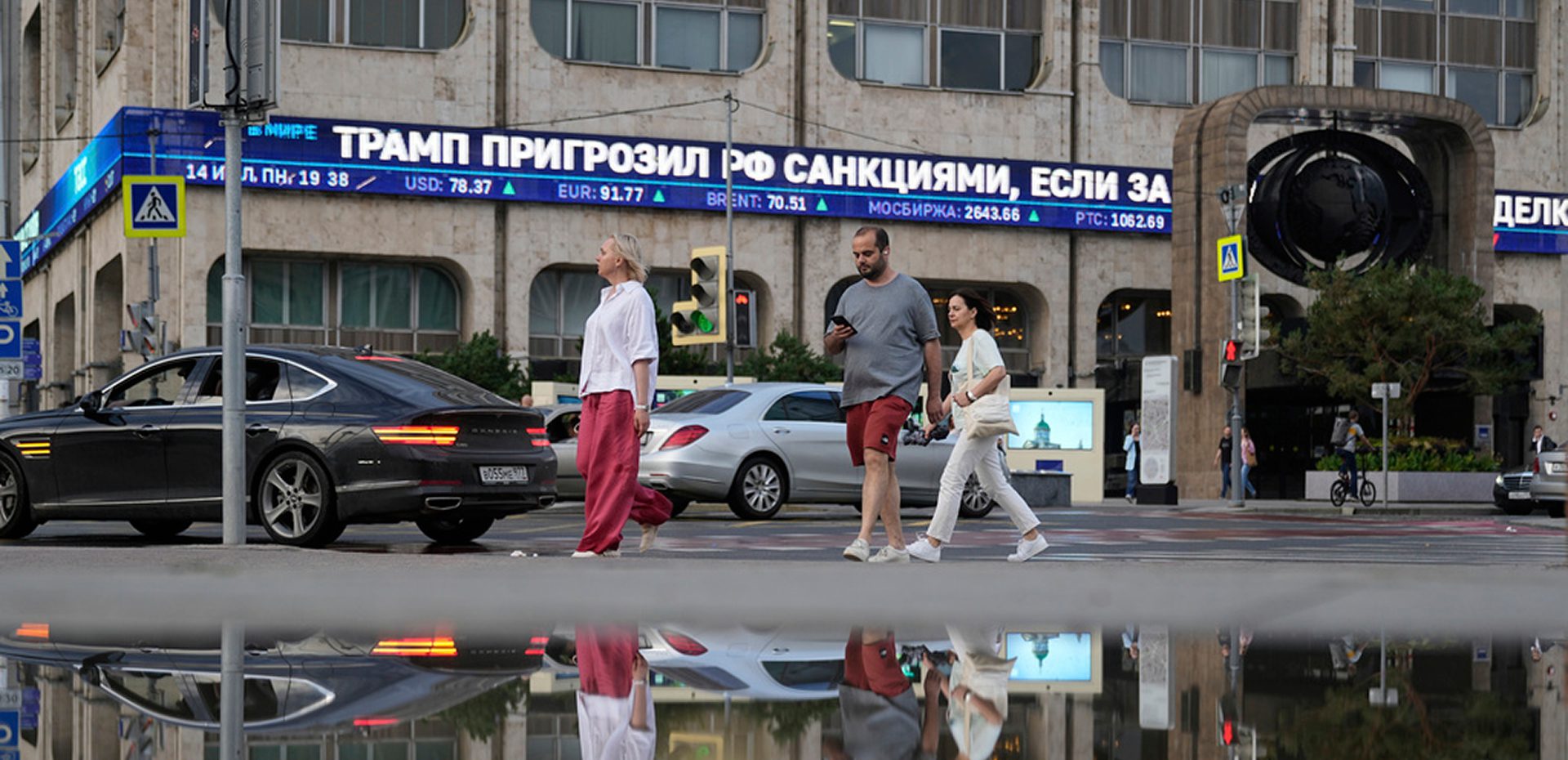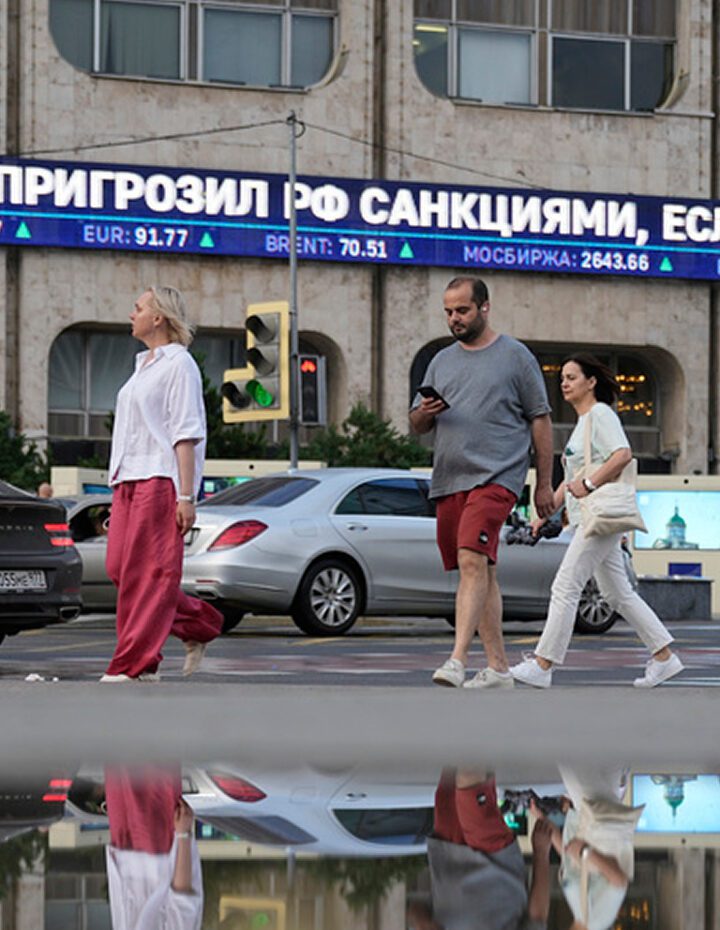Executive summary
- The decision to lower the Bank of Russia’s key interest rate to 17 per cent was made under political pressure and does not necessarily reflect underlying macroeconomic conditions.
- GDP growth in the second quarter amounted to just 0.4 per cent quarter-on-quarter (1.5 per cent year-on-year), falling short of offsetting the contraction recorded at the beginning of the year.
- The main drivers of economic activity were the defence industry and agriculture, while the extractive sector – traditionally the key source of growth – exerted the greatest drag on the economy.
- According to Ministry of Finance estimates, the federal budget deficit may reach 5.6 trillion roubles by the end of the year – 1.8 trillion roubles above the planned level. The ministry intends to cover the gap through increased market borrowing.
- Investment activity continues to decline steadily: since October last year, the index for indirect investment activity has fallen by 9.3 per cent.
The rate decides everything
On 12 September, the Bank of Russia lowered its key interest rate from 18 to 17 per cent. The decision, taken at a meeting of the Board of Directors, was made under strong pressure from the government and major business interests, who argue that the Central Bank is to blame for economic stagnation and that only a rate cut can stimulate growth. In the run‑up to the meeting, most commentators – including government representatives – adopted an assertive stance, calling for a reduction of 200 basis points.
On the one hand, inflation deceleration in the spring – driven by the sharp appreciation of the rouble and cheaper imports – and seasonal deflation over the summer caused by the arrival of the new harvest of fruits and vegetables widened the gap between current inflation levels1 and the Bank of Russia’s key rate, making it difficult to justify a continued tight monetary policy. In public statements, Bank officials also attributed the slowdown in inflation to the effect of the previously elevated key rate and argued that, since policy targets had been met, there was no longer a need to maintain the rate at its previous level.
On the other hand – and this was already evident in July, when the Bank of Russia cut the rate from 20 to 18 per cent – the overall statistical picture, particularly trends in household inflation expectations, raised doubts about the sustainability of the disinflation process. Adding to this uncertainty, in the four trading days preceding the Board meeting, the rouble depreciated against both the US dollar and the Chinese yuan (by 4.7 and 5 per cent, respectively), fuelling concerns over a potential further devaluation and, consequently, a renewed acceleration of inflation.
The ambiguity of the situation was reflected in the alternatives discussed at the meeting. According to the Governor of the Bank of Russia, Elvira Nabiullina, members of the Board considered both a 100‑basis‑point cut and leaving the rate unchanged. The latter option served as a reality check for many optimistic commentators who had insisted that there was no alternative to a rapid reduction in the key rate.
The absence of an obvious intermediate option – a 50‑basis‑point cut – clearly indicates the extent of political pressure on Nabiullina2. The Kremlin demanded a substantial reduction, and a cut of 50 basis points would not have satisfied its appetite.
The Bank of Russia’s caution in its rate discussions was likely also influenced by uncertainty over fiscal policy. At the post‑meeting press conference, Nabiullina repeatedly emphasised that the rate decision and the Bank’s forecast were based on the budget parameters approved by law for 20253. However, both President Vladimir Putin and Finance Minister Anton Siluanov had already acknowledged that the budget deficit and borrowing volumes in 2025 would exceed initial plans. When the draft 2026 budget was submitted to the Government – two weeks after the Bank of Russia’s decision – the Ministry of Finance stated that the deficit in 2025 would be one and a half times higher than originally projected: 5.6 trillion roubles compared with the 3.8 trillion roubles set out in the law. This calls into question the robustness of the Bank of Russia’s baseline assumptions.
Close to zero
In the second quarter of 2025, Russia recorded modest GDP growth of 0.37 per cent (1.5 per cent year-on-year), which helped to quell talk of an emerging recession and brought a sense of relief in the Kremlin. However, this growth was insufficient to offset the contraction seen earlier in the year. By the end of the first half of 2025, Russia’s GDP stood 0.2 per cent below the level recorded in the final quarter of the previous year.
The nature of Russia’s economic growth has shifted significantly. Unexpectedly, agriculture – alongside the defence industry – emerged as a key driver, while the extractive sector, traditionally the main engine of growth, exerted the most negative drag on the economy (see ‘Sectoral contributions to Russia’s GDP dynamics in the first half of 2025’).
‘Russia: sectoral growth dynamics, Q1-Q2 2025’ shows the distribution of Russian economic sectors by growth rates in the first and second quarters of the current year. Over the six‑month period, only three sectors (highlighted in green) demonstrated sustained growth: agriculture, forestry and fishing (A); manufacturing ©; and public administration, defence and social security (O). Growth in the latter two is unsurprising given the ongoing war in Ukraine. The expansion of the agricultural sector, however – particularly in the final quarter of last year – appears somewhat unusual, considering the relatively poor harvest in 2024.
Although the number of sectors that returned to growth in the second quarter after contracting in the first (highlighted in light purple) appears substantial, in most cases this merely reflects a rebound rather than genuine expansion. For example, the extractive sector (B) shifted from contraction to growth due to the gradual lifting of OPEC+ oil production limits. While the pace of growth was relatively strong – 1.45 per cent quarter-on-quarter, or 6 per cent in annualised terms – output in the second quarter of 2025 remained below the level recorded in the second quarter of 2014, and 8.3 per cent below the historical peaks seen in the second half of 2019 and early 2020.
The shift in the financial and insurance sector (K) from growth to contraction is explained by the impact of the Bank of Russia’s high interest rate, which required banks to raise deposit rates, thereby increasing their costs. At the same time, the economy’s transition into a stagnation phase has objectively undermined many borrowers’ ability to service their loans, prompting banks to increase provisions for potential losses. Both factors contributed to a decline in banking sector profits.
What is more surprising is the persistence with which Rosstat continues to report favourable developments in the construction sector (F), recording relatively strong growth in the first quarter and only a slight decline in the second, despite a five‑quarter downturn in the production of construction materials (see ‘Supply of construction materials in Russia’).
A predictable budget
Preliminary budget execution data for August brought no unpleasant surprises: restrained spending, which remained below average monthly levels, and higher revenues driven by dividend payments from Sberbank and VTB resulted in a budget surplus. Overall, expenditure dynamics are following a relatively even trajectory, with the final outcome for the year to be determined in December. As of July-August, revenue fell slightly below the forecast, but there is no basis at this stage to anticipate significant shortfalls by year-end.
Speaking at the Eastern Economic Forum in early September, President Putin effectively acknowledged that the annual budget deficit would exceed the planned level and that additional market borrowing would be needed to cover it. The Ministry of Finance’s revised deficit forecast, published at the end of September – 5.6 trillion roubles, 1.8 trillion roubles above the original plan – should not be seen as final. The actual figure will depend on the pace of government spending in December and could be even higher.
As of the first eight months of 2025, the accumulated budget deficit stood at 4.2 trillion roubles. This means that by the end of the year, the Ministry of Finance will need to secure 1.4 trillion roubles in additional financing. Market borrowing – via the issuance of federal loan bonds – remains the most obvious instrument. In the final four months of last year, the Ministry raised 2.1 trillion roubles through the domestic debt market4. An alternative, albeit less likely due to time constraints, is the receipt of significant privatisation revenues from the sale of Domodedovo Airport, which may be worth between 1.2 trillion roubles and 1.5 trillion roubles.
Investment collapse
After an 18-month break, the Centre for Macroeconomic Analysis and Short-Term Forecasting (CMASF) has published its Index of Indirect Investment Activity in Russia (see ‘Supply index of core capital goods’). The index is based on the dynamics of domestic production and imports of capital goods and construction materials, allowing it to exclude the effects of arms production, which is recorded as investment in the national accounts.
The picture is discouraging: since October of last year, the index has declined by 9.3 per cent, and by 11.5 per cent from its peak in mid-2023, apparently returning to levels last seen at the beginning of 2019. After a sharp drop in the supply of machinery and equipment at the turn of 2024–2025, its volume stabilised by mid-spring, while the supply of construction materials has been falling for 15 consecutive months.
Endnotes
- Annual inflation in Russia has been declining for five consecutive months – from 10.2 per cent in April to 8.1 per cent in August 2025 – reaching its lowest level since April 2024. ↩︎
- Central banks traditionally set interest rates in line with the position of the governor, and the Bank of Russia is no exception. ↩︎
- Although less than three weeks remained before the draft 2026 budget was to be submitted to the State Duma, the Ministry of Finance had not released any public information – not even on the general parameters of the budget – at the time of the Bank of Russia’s decision. This was a clear indication of serious internal disagreements between the Ministry’s efforts to uphold deficit limits and the demands of other government bodies seeking budget allocations they deemed necessary.
↩︎ - In December 2024, to meet its borrowing targets, the Ministry of Finance relied on support from the Bank of Russia, which provided state-owned banks with a 1 trillion roubles loan to purchase government bonds. This loan was repaid by the end of March 2025. ↩︎



